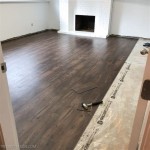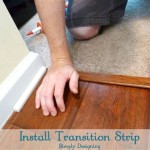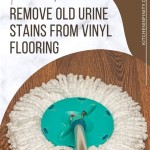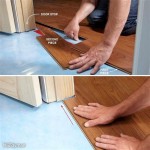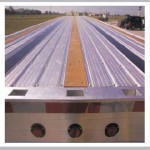How To Remove Old Linoleum Flooring
Removing old linoleum flooring can be a challenging but manageable task for homeowners. The process often involves dealing with stubborn adhesive and the potential for asbestos contamination in older homes. This article provides a comprehensive guide to safely and effectively removing old linoleum flooring, outlining the necessary tools, preparation steps, and removal techniques.
Safety Precautions and Preparatory Measures
Before commencing any removal work, safety is paramount. The initial step involves identifying the age of the linoleum. Homes built before the 1980s may contain asbestos in the flooring or the adhesive used to install it. Asbestos is a hazardous material, and disturbing it can release fibers into the air, posing significant health risks. If there is uncertainty regarding the presence of asbestos, it is crucial to have the flooring professionally tested. Local environmental protection agencies or certified asbestos inspectors can provide testing services.
If asbestos is confirmed or suspected, it is strongly recommended to hire a qualified asbestos abatement contractor to remove the flooring. Attempting to remove asbestos-containing materials without proper training and equipment can be illegal and dangerous. These professionals have the expertise, equipment, and safety protocols necessary to safely remove and dispose of the asbestos-containing linoleum.
Assuming the linoleum does not contain asbestos, the next step is to gather the necessary tools and materials. These include:
*Safety Glasses: Protects eyes from debris and dust.
*Gloves: Protects hands from sharp edges, adhesive residue, and cleaning solutions.
*Dust Mask or Respirator: Prevents inhalation of dust and particles.
*Utility Knife: For scoring and cutting the linoleum into manageable sections.
*Scraper (Floor Scraper): A long-handled scraper provides leverage for lifting the linoleum.
*Putty Knife or Chisel: For smaller, more detailed scraping.
*Heat Gun or Hair Dryer: To soften the adhesive and make removal easier.
*Plastic Sheeting: To cover and protect surrounding surfaces from dust and debris.
*Duct Tape: To secure plastic sheeting and contain debris.
*Garbage Bags or Heavy-Duty Trash Bags: For disposing of the removed linoleum and adhesive.
*Floor Adhesive Remover: Specifically designed to dissolve linoleum adhesive.
*Scrub Brush or Sponge: For applying and scrubbing the adhesive remover.
*Mop and Bucket: For cleaning the subfloor after adhesive removal.
*Vinegar and Water Solution: A natural cleaning agent for removing residual adhesive.
Before beginning the removal process, proper preparation of the work area is essential. Clear the room of all furniture and other objects. Cover any remaining flooring or surfaces with plastic sheeting and secure it with duct tape. This will help to prevent dust and debris from spreading to other areas of the home. Open windows and doors to provide ventilation, even if wearing a respirator.
Linoleum Removal Techniques
The method used for removing linoleum flooring can vary depending on the age and type of linoleum, as well as the type of adhesive used. Generally, a combination of techniques may be required to effectively remove the flooring.
The first step involves scoring the linoleum into smaller, manageable sections using a utility knife. This will make it easier to lift and remove the flooring in pieces. Make sure to score deeply enough to penetrate through the linoleum but avoid cutting into the subfloor. Depending on the size of the room, dividing the linoleum into sections that are approximately 1-2 feet square is usually sufficient.
Once the linoleum is scored, use a floor scraper to begin lifting the edges of each section. Position the scraper at an angle and apply steady pressure to separate the linoleum from the subfloor. If the linoleum is difficult to remove, a heat gun or hair dryer can be used to soften the adhesive. Apply heat to a small area of the linoleum for a few seconds, then immediately try to lift it with the scraper. Continue this process until the section is completely removed.
For areas where the linoleum is particularly stubborn, a putty knife or chisel can be used to carefully scrape away the flooring. Work slowly and methodically to avoid damaging the subfloor. Patience is key, as rushing the process can lead to frustration and potential damage.
As the linoleum is removed, immediately place it into garbage bags or heavy-duty trash bags. This will help to contain dust and debris and prevent it from spreading to other areas of the home. Once the bags are full, seal them tightly with duct tape and dispose of them properly according to local regulations.
Adhesive Removal and Subfloor Preparation
After the linoleum has been removed, a layer of adhesive will likely remain on the subfloor. Removing this adhesive is crucial for ensuring a smooth and even surface for the installation of new flooring. Several methods can be used to remove linoleum adhesive, including chemical adhesive removers and mechanical scraping.
Chemical adhesive removers are specifically designed to dissolve the adhesive, making it easier to scrape away. Before using any adhesive remover, carefully read and follow the manufacturer's instructions. Apply the adhesive remover to a small area of the subfloor and allow it to sit for the recommended amount of time. Then, use a scraper or putty knife to remove the softened adhesive. Be sure to wear gloves and safety glasses when working with adhesive removers, as they can be irritating to the skin and eyes.
Mechanical scraping involves using a scraper or putty knife to physically remove the adhesive from the subfloor. This method requires more effort than using chemical adhesive removers, but it can be effective for removing stubborn adhesive. Work slowly and methodically to avoid damaging the subfloor. A heat gun or hair dryer can be used to soften the adhesive before scraping.
Once the majority of the adhesive has been removed, clean the subfloor thoroughly with a scrub brush or sponge and a solution of vinegar and water. This will help to remove any residual adhesive and prepare the surface for the installation of new flooring. Allow the subfloor to dry completely before proceeding.
After cleaning, inspect the subfloor for any damage, such as cracks, holes, or unevenness. Repair any damage before installing new flooring. Small cracks can be filled with a patching compound, while larger holes may require the replacement of a section of the subfloor. If the subfloor is uneven, it may need to be leveled with a self-leveling compound.
Before installing new flooring, prime the subfloor with a primer recommended by the flooring manufacturer. This will help to ensure proper adhesion of the new flooring and prevent moisture from seeping into the subfloor.
In summary, removing old linoleum flooring requires careful planning, preparation, and execution. By following these steps and taking appropriate safety precautions, homeowners can successfully remove their old linoleum flooring and prepare their subfloor for the installation of new flooring.

What You Should Know About Removing Old Linoleum Or Vinyl Flooring Hq Longwood Fl

How To Remove Vinyl And Linoleum Flooring 2024 Today S Homeowner

How To Easily Remove Linoleum Houseful Of Handmade

Diy Vinyl Or Linoleum Flooring Removal Dumpsters Com

How To Replace Linoleum Floor In A Correct Way

How To Remove Old Vinyl Or Linoleum Flooring Kitchens And Bathrooms

How To Remove Linoleum 13 Steps With S Wikihow

How To Remove Linoleum 13 Steps With S Wikihow

Tearing Out Old Kitchen Flooring Planitdiy

Our Kitchen Renovation Part V Removing Linoleum
Related Posts

